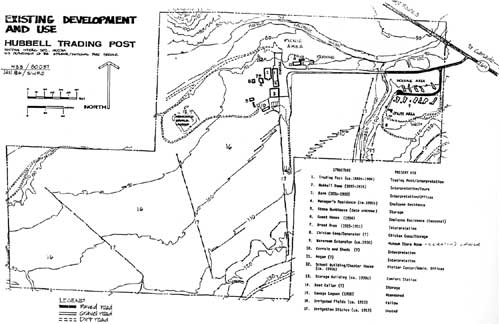|
Hubbell Trading Post
Administrative History |

|
EXECUTIVE SUMMARY
The movement to bring Hubbell Trading Post into the National Park System started in 1957. Hubbell Trading Post National Historic Site was established by Act of Congress on August 28, 1965. Public Law 89-148 authorized the purchase of the "site and remaining structures of the Hubbell Trading Post at Ganado, Arizona, including the contents of cultural and historic value, together with such additional land and interests in land...needed to preserve and protect the post and its environs for the benefit and enjoyment of the public. "During the 1965 Committee on Interior and Insular Affairs hearings concerning the proposed establishment of the old trading post as a national historic site, it was indicated that "arrangements should be worked out to have it operated along lines close to those that were in effect when it was an active post."
The trading post, as a national historic site, is still operated as a trading post, although the actual running of the business end of the site is under the direction of Southwest Parks and Monuments Association, which employs a Trader/Manager, Bill Malone, and many full-and part-time clerks. This arrangement, unique in the Park System, is governed by a cooperative agreement. Tourists visit the site, but so do Navajo who come to trade their arts and crafts and buy groceries. This is a real-and active-trading post, not specifically a museum.

|
| Figure 1. Vicinity of Hubbell Trading Post National Historic Site. |
As an important point of fact, the trading post was an active trading post when the Park System stepped in to manage the site. Dating from the mid-1870s, it was the oldest trading post still in operation on the Navajo Reservation, and it was the oldest business still operating in northern Arizona. When the NPS and SPMA came in the 1960s to manage the site and run the business, the trading post was owned and operated by Dorothy Hubbell, the daughter-in-law of its founder, John Lorenzo Hubbell. When the NPS and SPMA took over, there was a change of administration, that's all.
Full title to the property was acquired in 1968. There are 160 acres of land acquired in fee simple, of which approximately 110 acres are potentially irrigable. The trading post was also a farm; the fields have lain largely unused since about 1964. (There are problems with the dam at the reservoir, Ganado Lake, about two miles from the historic site; irrigation water has not been able to be moved through the ditches, which are becoming filled with weeds and drifting sand.) In order for Hubbell Trading Post to regain historical accuracy, farming should be reintroduced.
The cultural resources of the historic site are surprising and significant. Management has to be concerned with the maintenance of a complex of structures built between the last decades of the nineteenth century and the first few decades of the twentieth century. There are a number of archeological sites within the boundaries of the historic site, and these archeological sites are evidence of human habitation here for thousands of years. One archeological site, Wide Reed Ruin, is of considerable significance all by itself. Virtually no attempts are made to interpret for the public the thousands of years of Indian habitation here. The museum collection, all of which was acquired with the historic site, is one of the richest in the Southwest. The collection consists of ancient and modern Indian arts and crafts, modern objets d'art, old farm implements and frontier tools, antique firearms, household furnishings from the late nineteenth century to the early decades of this century, and just an incredible assortment of household odds and ends and business paraphernalia that has been found at the site. A full-time curator and assistant are on duty at Hubbell Trading Post to maintain and catalog the thousands of artifacts.
Management and development decisions at the historic site must comply with the provisions of the Antiquities Act of 1906, the National Park Service Organic Act of 1916, the Historic Sites Act of 1935, the National Historic Preservation Act of 1966 (as amended), the National Environmental Policy Act of 1969, Executive Order 11593 of May 13, 1971, the Historical and Archeological Data Preservation Act of 1974, the Archeological Resources Protection Act (P.L. 96-95) of 1979, and P.L. 89-148 authorizing the area, as well as the congressional hearings of 1966 during which Director George Hartzog committed the Park Service to running a live trading post.
The mission of the Park Service at the historic site is of course the protection and preservation of the site, but, and this is unique in the Park System, the site is also intended to perpetuate, for as long as possible, the trading post business as an example of that kind of business. This is the only trading post owned by the American people. It is important to note that although this historic site has museum-like aspects, it is not a museum, and for the most part is not a site intended to be "frozen in time." This may be our only historic site that is intended to go on evolving, a real business that will change as the Navajo themselves change.
Hubbell Trading Post National Historic Site is in Apache County, Arizona; which is the most northeasterly of Arizona's counties, and it is entirely surrounded by the Navajo Nation.

|
|
Figure 2. Map of
Hubbell Trading Post National Historic Site. (click on above map for an enlargement) |
| <<< Previous | <<< Contents >>> | Next >>> |
hutr/adhi/adhi0b.htm
Last Updated: 28-Aug-2006